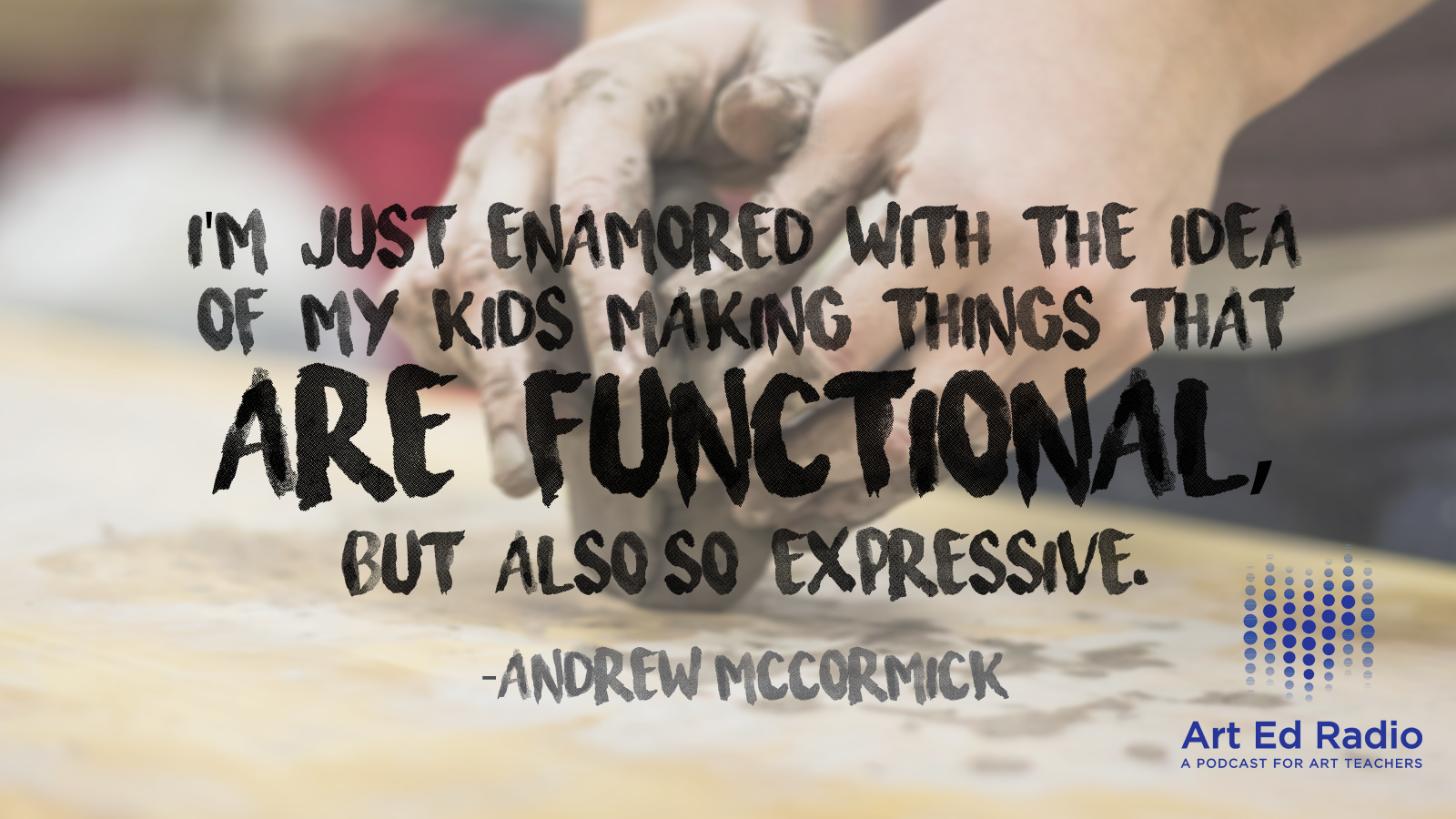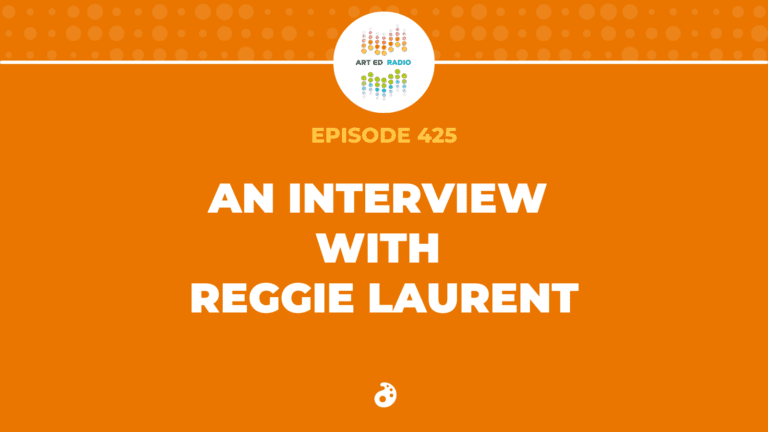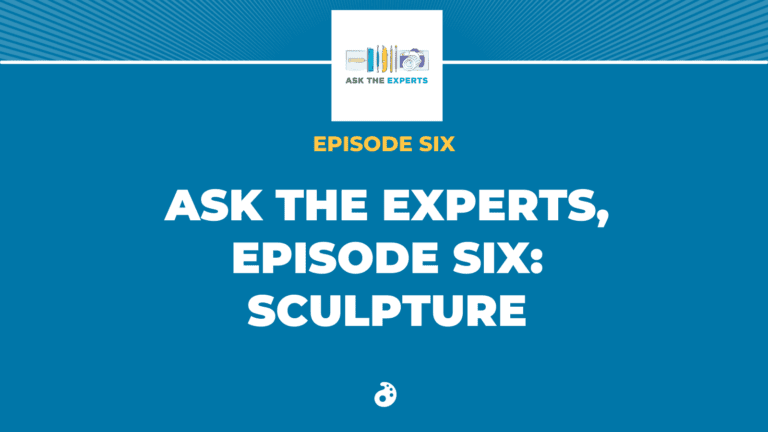We are on to Learning to Love Ceramics, the sequel! So many teachers have a love/hate relationship with teaching ceramics, but the Radio Guys want to convince everyone they can love ceramics like they do. They try to cover everything they couldn’t get to in the last episode, including their favorite ceramics projects to teach (4:00), advice to teachers that aren’t as comfortable with ceramics (8:30), and their best strategies for making glazing a success (12:00) If you missed the first part of the episode last week, make sure you give it a listen! Full episode transcript below.
Resources and Links:
Check out Part 1 of the podcast
How to take your basic ceramics projects to the next level
50 Amazing Clay Resources from AOE
Check out the Studio: Ceramics course

Transcript
Welcome to Art Ed Radio, the podcast for art teachers. This show is produced by The Art of Education, and I’m your host, Tim Bogatz. On the Art of Ed website a couple weeks ago, we published an entire week of ceramics articles and videos, just a huge variety of ideas for you, new projects, best practices, just a lot of fun and creative stuff. Andrew and I joined the party too with our first episode about ceramics last week. We talked about a lot, and covered a lot of information. Our favorite ceramics hacks, ideas for organization, how to be successful with your firing processes. If you missed it, go and check it out. It was a fun one. However, we didn’t get through everything we wanted to cover. We were apparently more enthused about ceramics than we originally thought, so this conversation is spilling over into episode two, right here, right now. It’s Learning to Love Ceramics, the sequel.
We’re going to talk today about a few of our favorite projects that we do, our favorite ideas with glazes and glazing, and some of the big-picture thoughts about how and why we teach ceramics the way we do. Like we said last week, we’re hoping that this is a conversation that shares with you some ideas that can make teaching ceramics a little easier for you, maybe a little less scary, because we know how much my partner in crime here likes to talk, so I’m going to cut this introduction short and go ahead and start the conversation. Let’s get to it right now. And I am bringing Andrew McCormick on. How are you, Andrew?
Andrew: Good, good. I’m feeling a little sassy and salty tonight, so I think this ought to be a good conversation.
Tim: All right, I like it. I like it. This should be fun. So last week we talked so much about ceramics that we literally could not fit it all into one episode, so we’re spilling over to part two tonight, and I want to talk a little bit about our favorite projects, or our best projects, that we like to do, and then I want to get into a little bit on glazing and firing, because I feel like those are the big things that we missed out on last week, so let’s start talking about projects. I know last week you had mentioned a thing about the mask project that you like to do, and I know people are kind of curious about that one, so can you kind of explain your process for the mask, what you do to build that, what you’re trying to teach kids with that project?
Andrew: Sure. Well, let me just start off by saying, I’ve never had the luxury of, or maybe the curse, depending on how you look at it, of having to teach throwing on the wheel, because I’ve never had a high school gig where I had to teach ceramics and really dive deep into like functional throwing on the wheel, so all the ceramics …
Tim: Yeah.
Andrew: … I do is sculptural, so a lot of things kind of gravitate towards things with texture, things with sculpture, carving. I do a lot with faces, maybe that’s my own kind of prejudices or interests in making faces, but …
Tim: Yeah.
Andrew: … I feel like with a mask, there’s a lot of art history that you can bring in, there’s a lot of contemporary artists that deal with that. You can also deal with a lot of symbolism and identity, what does this mean to have a face that’s not your face, but that in some regards could be worn, although I almost never make masks in ceramics to be worn. It’s just kind of a …
Tim: Right.
Andrew: … decorative thing. But I’ve always liked doing it, and I think it works pretty well. One of the things I teach is kind of how to make a, we start with a slab, how to make kind of like a hump or a mold out of just like plastic bags and just kind of …
Tim: Yeah.
Andrew: … curl some bags unto themselves, kind of under and around, and you just kind of make this like half dome oval shape, put a couple of pieces of tape around that just so that the bag stays kind of compact and where you want it, and then we just kind of drape that slab over that, and it’s kind of the basis, and then we talk about additive and subtractive sculpture, so carving things away, embossing into it, but then also adding noses, ears, horns, lips, all of that stuff, and it’s been really fun. I’ve been doing it for a couple years now.
Tim: Yeah, that sounds really cool, and I love that you have a very specific thing you want, but yet you kind of keep it open-ended, and I think that’s a really cool thing that I think that makes for a good project. So I want to tell you a little bit about my favorite sort of slab project that I do. We call it animated houses, okay, where we’re trying to build a house, but you want to make it look more expressive, more animated, more fun, and the way we do this is, again, we’re making slabs, we’re constructing with slabs, kind of like you talked about, but our rule is, no straight lines, and so you think about kids like sculpting these houses, but then they almost turn into these like Tim Burton Nightmare Before Christmas houses.
They’re like, imagine Dr. Seuss drawings turned into like sculptural houses, and so we have these like weird curves, strange windows, strange doors, all these extra details, all kinds of cool texture, cool roofs, building the surroundings, and kids really get into that, so that’s a great intro project where you’re just building with slabs, and it teaches them about construction, but you still get this really cool end product, and a lot of creativity that kind of goes along with that. But if I can ask you, like can you expand a little bit more on sort of your face thing that you talked about? You just mentioned that real quick, but can you share some of the projects that you like to do that have to do with faces or creatures or personalities?
Andrew: Yeah, sure, and I don’t know, I think maybe it’s because like … I don’t know if other people find this to be true, but I find that especially boys who get into art, if you talk to them about how they grew up drawing and being into art, I find that they either fall into a cars-and-Hot-Wheel camp, or kind of a superhero-comic-book-action-figure camp …
Tim: Yeah.
Andrew: … and I was definitely like the comic book camp, so I’ve always been like, I’ve always enjoyed drawing portraits and faces, so I think some of that keeps showing up in my own work that I want to do with kids, but I try to give them other opportunities too. But one of the ways that I kind of differentiate between like eighth-grade art and ninth-grade art is, I do a project in eighth grade where we talk about face jugs and kind of the tradition coming out of like the deep South and …
Tim: Yeah. Yep.
Andrew: … slavery traditions, and how people would make face jugs, and then we kind of spin that forward into contemporary artists who are also kind of enamored with that idea of making something that’s both functional, but then also has some expressive characteristics to it, and one of the reasons why I like doing face jugs, I’ve also done sort of a interpretation of that called monster mugs, where they have to make like the biggest mug that they can, and then put like this …
Tim: Yeah.
Andrew: … grotesque face on the outside, is … With face jugs, the history of that is that they were exaggerated and extreme and wanted to kind of communicate expressively. It wasn’t just a, “Here’s a face, and it looks like this person,” so I think students like it because they are practicing kind of building a face and building portraiture and sculpture, but it doesn’t have to be realistic, so the noses can be all crazy, and the eyes can be crazy, and the mouth can be nuts, and …
Tim: Yeah.
Andrew: Kids just kind of really like that, and I would actually say that’s my MO in a lot of projects, like I don’t want my students to be so worried with perfection and doing it right, so we give it a little curveball, so they’re …
Tim: Yeah.
Andrew: … doing something, but then they’re not worried about doing it wrong or right.
Tim: There’s such a learning curve with ceramics, like it’s so tough to do things realistically, and so that exaggeration, or leaving things open to interpretation, I think, is a good method to help kids find success, but let me ask you this, and we’re talking about learning to love ceramics, and I talked a little bit last week about how, when I got started, I had no idea what I was doing with ceramics, and so I guess what’s your advice for people who maybe don’t know about a technique, or they haven’t tried it before? Like are you in the, “Make sure that you do everything beforehand so you’re an expert at this,” or you just dive in with your kids and figure out what you’re going to do as you move along? Like what approach would you recommend people take?
Andrew: Well, that’s interesting, because I feel like we could divide art teachers into those two different camps, and I think it’s hard if you’re in one of those camps to then like all of a sudden be like, “Well, this semester I’m going to be in the other camp.”
Tim: Yeah.
Andrew: Because I am definitely like a, “Learn how to fly as you jump off the cliff,” like let’s just figure it out halfway through, and I could say, “Well, this semester, I’m not going to do any of that, because I might have a failure along the way, and I’m going to be really straight-laced, and I’m going to have everything planned out,” and it just won’t work. It won’t work for me, and vice-versa. Someone who really likes to be planned out and detail-oriented is going to feel really uncomfortable just learning how to fly midway through, and I don’t know, so that’s kind of my MO, but I think it’s probably up to each person.
I mean, the thing that makes ceramics a little more scary in that regards is, there are some real consequences for not doing ceramics right. I mean, things can break, things can explode, things can not work, but I think if you tell your kids like, if something did blow up, because I’ve had some things blow up, and it’s like, well, that kind of, that stinks, but it’s also about the process and the journey and what you learned along the way, and as we go forward, we won’t make those mistakes again, and we’ll learn from that, so I don’t know. I don’t know if I really answered your question, but it’s kind of a tough one to answer.
Tim Bogatz: No, that’s okay. It’s good that I’m asking tough questions, I’m trying to put you on the spot here. No, but I would encourage people to just dive in, because I think with ceramics, if you’re scared of it now, you’re always going to be scared of it. Like you’re not going to ever just dive in, and I think you just need to take the plunge, because if you wait around until you’re an expert, you’re not going to become an expert. You’re not going to take the time outside of class to learn to do … Like if you’re honest with yourself, you probably will never get there unless you just dive in and do it, and …
Andrew: Yeah.
Tim: … so I think it’s worthwhile to jump in with your kids. I think your students will be understanding. Just tell them, “We’re learning this together. We are going to go through this process together.” You can work with them, you can explore with them, you can try things out with them, and each time you go through that, you’ll be a little bit better the next time you teach it, and so I think it’s worthwhile to just give it a try, so … That’s my advice, if you are wanting to learn to love ceramics, I think you need to just dive in and do it, but let’s shift, though. Like after we have all of these really cool projects done, they’re fired, and by the way, if you guys missed our conversation on firing and making sure things don’t blow up, check out part one of the episode, so we don’t need to cover that again.
But let’s talk glazing technique. So what, I guess, is your overall idea with glazing? Like what do you want your kids to accomplish, and part two, I guess, do you have any tips and tricks that you want to share to either make things a little easier for you on the teacher end, or tips that might help product turnout better once things have been fired, like what you can help the kids learn with glazing?
Andrew: This is weird, but I think I might start with one of the things that drives me crazy with glazing …
Tim: Okay. Yeah.
Andrew: … is, a student makes a project, and it’s all right, it’s pretty good, and then it’s like time to glaze, and it’s like, “Blue. I like blue,” and it’s just one color, everywhere. You’re just like, that is just such a boring interpretation of what is …
Tim: Yes.
Andrew: … possible with glazes, so one of the things that I’ve been really trying to stress is like, pick multiple colors, colors that look good together. Think about kind of a focal color or color that kind of carries the day, and then have accent colors, and I try to show them things like, you can drip this color on that color.
Tim: Yeah.
Andrew: When these colors match, it’s going to make something maybe like this, but there’s going to be a little trial and error and a little surprise involved with that. I’ve also been trying to do a lot of like, put a color in, sort of the low spots in their texture, then take a sponge and wipe that all off, and then put a lighter color on top of that, and the students are always convinced, “That’s not going to work. I’m not going to see that darker color in those cracks.”
Tim: Yeah.
Andrew: I’m like, “Yes, you are. Trust … ”
Tim: Yes.
Andrew: ” … me, it’s going to work.” Just some different ways to get them to think outside of, “I like blue. This is a tree. It is brown. Leaves are green.”
Tim: Yes.
Andrew: It’s like … So another way I try to do that is, I do try to pick glazes. I have some glazes that are pretty straight-laced, robin’s egg blue, opaque white, but then I also try to pick a lot of colors that have sort of some nuance and some texture, and when they’re a little thicker, they’ll bust a little more orange, or more tan, so that they don’t have many opportunities for their glaze to, even if they do just only pick one color and I don’t watch them closely, it’ll still be a little bit more interesting and nuanced. So I’d have to say one of my big things is, I want them to explore, I want them to be open to lots of different interpretations, and I want them to have a lot of fun with that, so that’s kind of my big MO. I’ve been talking a lot about glazes, but I do want to say this. One of the epiphanies I had about a year ago, I’d always just kind of inherited the bucket of textiles, you know …
Tim: Yes.
Andrew: … this one box, or this bin, or this bucket. You have a class of like 24, 26, 30 students, and it’s like, “Okay, go find your colors,” and it’s this total bottleneck at this one spot. And I thought, “This is so silly. I should mount them or glue them to some sort of board. Then I can put the board up,” and usually I just do it like on the whiteboard tray, you know marker tray …
Tim: Yeah.
Andrew: … and then rest it up against the whiteboard, so then people can, like all of my students, can look at it at the same time, jot down like a little list of like, “I want this color, this color, and this color,” and it just really streamlines the process of like picking colors out. I’ve even gone so far, because I know one of the things is, kids from day to day will forget, “Did I have amethyst or lilac, or did I have Mardi Gras or snow fire,” and I’ve actually used my learning management system to start a discussion board, and then students actually have to like write on the discussion board, “I’m going to use this color, this color, this color.”
So when we come back a day later or two days later, or even post-firing, and they’re like, “That was amazing! How did you make that,” that we can look up and say, “Well, that was this color and this color, and those combinations made this,” so that’s been a nice little trick that I kind of stumbled on about a year or two ago.
Tim: Yeah, I think that’s cool, and I was more old-school, never really did this through a learning management system, but I just had a glaze record, or even had kids write things down on note cards where they would mark down what glazes they were using, what they thought would happen, and then, when they turned that in, they would reflect on what did happen, how it differed from expectations, what they’d like to do differently next time, etc., etc. And that really, after you’ve done six or eight projects and you have like a little catalog of glaze records, kids are really learning a lot about the glazes in your room and what you can do with them, so …
But I wanted to share just a couple things real quick. The biggest thing for me, which, I don’t know why kids aren’t learning this before they get to me in high school, but just simple glazing techniques where we do three coats and brush strokes with them to make sure that you’re covered, like … First coat, brush strokes go up and down, second coat, side to side, third coat, diagonal. Super easy to teach, and it just keeps things really, really consistent, and that can be from elementary through high school. I mean, just a simple thing of changing up the direction of your brush strokes so that your glaze is applied evenly, it looks even when it’s fired. I think that’s a simple thing that’s really, really huge.
And then, I was super impressed for, I don’t know who all went to the, or saw the Art Ed Now Conference over the weekend, but John Post and his glazing technique was absolutely spectacular, and for those of you that didn’t see it, basically, he’s got two things going on. One is sort of a little hotplate or a little crock-pot with just a little tiny bit of wax on the bottom of it, and then he’s got a huge bucket of glaze, and he just takes the tongs, puts the kid’s project in the wax, so it’s got a coat of wax on the bottom, and then, as soon as that’s dry, he dips it into the white glaze that he has, okay, lets that dry.
The whole process takes like 30 seconds, and then the kids put one coat of colored glaze over the top of that white, and … Everything turns out spectacularly well, he saves so much money doing glazes, he doesn’t have to use stilts when he’s firing because of the wax on the bottom, and it’s just the smoothest process, where, dips the bottom in wax, dip it in glaze, let the kids add color on the top of it, and it’s like the smoothest thing ever. So I thought that was really, really impressive, but … One more thing I want to get from you. You told me about a carpet trick, but you really didn’t explain that at all, so I’m intrigued, and I want to know what you’re talking about there.
Andrew: Well, so as teachers, we’re always trying to evolve, and I was just kicking around on Facebook one night and I saw this trick that I have actually not tried yet, but it looks really smart to me, because I have actually not done the John Post glazing trick, technique, and I always tell kids, “Don’t put glaze on the bottom, one eighth of an inch, or a quarter of an inch of the pot,” and I always have three or four kids every class that just go nuts on the bottom, and I’m like, “Oh, you guys.”
And then as teachers, we’re sitting there, scrubbing with our sponge to get all that junk off, and the bottom of the pot can be kind of rough, and maybe the kids didn’t even bother looking at it, might be a little bumpy or whatever. It can really beat up some of your sponges. Now, I saw this guy who he took a piece of like carpet remnant, something that had, like, a decent amount of shag to it …
Tim: Yeah.
Andrew: … like a thickness to it, put it in a bin like a tote, like a skinny, under your bed tote, and then put some water in that, and you just take whatever pot or ceramic piece that a kid glazes the bottom of, and you just rub it on that carpet, kind of like a dog rubbing its butt. You just kind of rub it, and it gets all the glaze off the bottom, and you’re not having to beat up all your sponges, and it just looks so much faster, so much easier …
Tim: Yes.
Andrew: … and I’m really excited to try that out. Yeah, I just got to find a good-sized carpet …
Tim: Yeah, I like that.
Andrew: … remnant, yeah.
Tim: Now that’s a good plan. All right, I want to share one last thing, and then we got to get out of here because I do not want this going to part three, so … My other favorite glazing thing is what we call the mystery glaze bucket, and I’m sorry I can’t credit whoever I got this idea from, I don’t even remember, but it’s spectacular. Basically, you just have a big old five-gallon bucket in your room, could be smaller, but any time your jar of glaze gets down to that just last little bit, okay, you go and you dump the remainder into the mystery glaze bucket, and slowly this, like, builds up over time, and then once you’ve got a good amount of glaze in there, you can either brush it on, you can dip it on, but it’s just a mixture of whatever 20 glazes that you have in your art room, and you have no idea what it’s going to be each time.
And so, for those kids that are brave or don’t know what they want to do, the mystery glaze is quite a bit of fun, to just go over to that random bucket full of random glazes and take your chances with what might come out, so that’s always a fun one to do, too, so …
Andrew: Yeah, that’s cool. That’s cool. I like that.
Tim: Yeah. All right, cool. Well, we are up against it, and we need to get you out of here, so Andrew, thanks for talking ceramics with me once again, and yeah, appreciate you coming on.
Andrew: Yeah. My pleasure, man. We’ll see you later.
Tim: All right. I feel like that covers it. I think we could probably talk a little bit more, but I think two episodes is going to be enough. I hope we’ve encouraged you with this conversation to try something new in ceramics, and encouraged you to try something more. Now, before I let you go, I need to tell you one more time about the ultimate shortcut for learning how to teach ceramics, AOE’s Studio: Ceramics course. If you take this course, you’ll learn it all in eight weeks. Throughout the course, you will experiment with a ton of hands-on, advanced ceramics techniques, using slips, underglazes, texture treatments, hand-building techniques, and make all sorts of great connections to the rest of your curriculum. You can create tools and finished pieces for the classroom, and you’re going to learn how to break ceramics skills down for your students in a way that’s developmentally appropriate. So no matter what age or what level you teach, you’re going to find a lot of information to help you out. Visit theartofed.com/courses to check it out. There is a new section of the course beginning every single month.
Now, before we wrap it up, I just want to say one last thing. I hope that, because of this conversation, you want to try something new in ceramics, and I hope that you’re encouraged to try to do something more. Hey, if there’s one overall big idea, I think it should be this. Don’t be afraid to dive in to teaching ceramics. Hey, don’t wait to become an expert before you try something, because kids don’t learn from one clay project a year. They need that repeated exposure to ceramics. Hey, that’s what’s going to teach them. It’s what they’re going to enjoy. So dive in, even if you don’t know everything about what you’re doing. Learn along with your kids. Teach them something about the process of discovery and the process of exploration, and if you take it that way, both you and your students just might learn something.
Art Ed Radio was produced by The Art of Education with audio engineering from Michael Crocker. Remember that you can sign up for our email list at artedradio.com. For those of you that are already on the list, we’ve got something for you to look out for. Hey, we’ll have a survey about the podcast with a few questions for you to answer coming really soon. Andrew and I are always trying to get better at what we do, because we want this podcast to be the best it can be. We want to hear from you, your opinions, your ideas, so be on the lookout for them. And like I always say, we want to know your thoughts, good, bad, and otherwise. And, as always, thank you for listening.
Magazine articles and podcasts are opinions of professional education contributors and do not necessarily represent the position of the Art of Education University (AOEU) or its academic offerings. Contributors use terms in the way they are most often talked about in the scope of their educational experiences.



